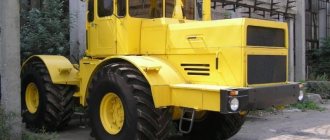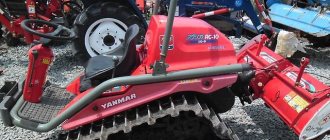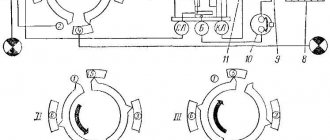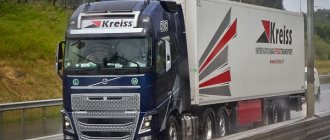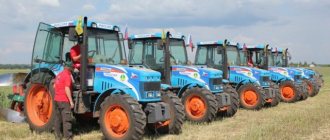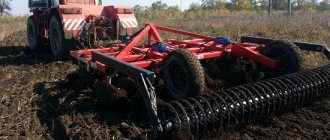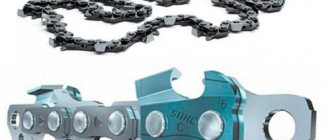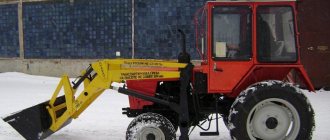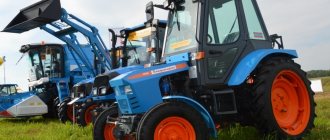Heavy work requires powerful and productive equipment. Understanding of this appeared more than half a century ago, when the 700 series tractors were produced at the Kirov plant. Units of the K-701 model belong to the second generation of these heavy machines, used primarily in agriculture and road work.
Tractor "Kirovets" K-701
The first samples of the K-701 rolled off the assembly line in 1975, and their production in various modifications continued until 2002. This is one of the tractors that has become widespread in large-scale work - cultivating large areas of land, building roads, and eliminating the consequences of natural disasters.
The advantages of this model are:
- reliability;
- ease of maintenance;
- high maintainability;
- long service life;
- simplicity of design;
- lower cost compared to modern models.
The design flaws of the Kirovets tractor, which officially became one of the reasons for the removal of the K-701 tractor from production, include:
- less cross-country ability in difficult conditions (due to the significantly protruding engine);
- the possibility of the car overturning when driving on roads with large uneven surfaces;
- low enough ground pressure for some agricultural work (although acceptable for use in marshy areas).
High performance properties led to the fact that the tractor was produced under license in Poland, as well as at a number of domestic factories in an improved form.
Units based on the K-701, made in the form of a tractor, as well as vehicles with a living compartment (KUNG), designed to work in particularly difficult swampy and arctic conditions, have been developed and are in operation.
The ergonomic two-seater cabin is equipped with a heating system and can be equipped with air conditioning. The tractor cabin is covered with a durable protective frame and is designed to withstand heavy objects tipping over and falling onto the roof.
Photo of tractor K-701
Advantages and disadvantages
Many years of experience in operating Kirovets 701 model tractors have proven their full suitability for solving complex and large-scale tasks. The list of undeniable advantages:
- reliability of the engine, main and auxiliary units, on-board hydraulic system;
- free access to the structure, which simplifies the performance of routine and repair work;
- Operators highly appreciate the maintainability of this model, the unification of consumables and spare parts with different versions of K-700 tractors;
- For agricultural technologies, the ability to attach a large assortment of productive wide-cut machines, including those produced in previous years, is of great importance.
A small list of disadvantages includes:
- lack of full elastic suspension of the chassis;
- a forward shift of the center of gravity due to the heavy power unit protruding beyond the front half-frame;
- the ability to perform labor-intensive repair work only if there is a crane or other similar device with a lifting capacity of up to 3 tons.
Device
Maneuverability and traction of all wheels with the soil are ensured by two semi-frames that move relative to each other. The main part of the working units is mounted on the front semi-frame, which has increased strength. The tractor wheels (4 in total) have equal dimensions, operate at low pressure and are equipped with an all-terrain tread.
Engine
The model is equipped with a 12-cylinder high-power diesel engine (300 hp), which is mounted on one front and two rear supports. The engine is installed in the front semi-frame of the tractor, the vibrations of which are damped by effective rubber shock absorbers.
The cooling fan has automatic speed control to help maintain optimal temperature conditions.
To ensure cold starting, a comprehensive engine and fuel heating system is used. Driving off can be done only after heating the coolant to a temperature of 40-50 °C.
The diesel air filtration system is two-stage. At the first stage, processing takes place in a cyclone, after which the air, purified from the coarsest impurities, passes through a high-porosity cardboard filter. A clogging indicator is used to visually monitor the condition of the air system.
Tractor transmission
The transmission system includes a semi-rigid clutch, gearbox, axles and cardan drive. The pump drive gearbox is connected to the transmission clutch. Both axles (front and rear) are driven, and the rear axle can be disengaged. This reduces fuel consumption without the need for high power output.
The gearbox has 16 forward and 8 reverse speeds. The gearbox is installed on the front semi-frame of the tractor and secured through shock absorbers with four brackets.
Hydraulics
Work with attachments is carried out using a separate hydraulic system. In total, two NSh-100 pumps are installed in the tractor, one of which works to meet the needs of the tractor, and the second goes to the attachments.
Tractor diagram K-701
Adjustable distributors, which are equipped with models of recent years of production, allow the operation of most imported agricultural equipment. Hydraulic operation is integrated into the gearbox and steering system.
Electrical equipment
Engine starting is ensured by an 8.1 kW electric starter. It is powered by two batteries (12 V), which are switched from parallel to serial connection to run.
The tractor generator is three-phase and has a silicon rectifier (produces direct current).
The functions of the electrical system are used to solve problems:
- ensuring engine preheating;
- starting a diesel engine;
- power supply system;
- functioning of heating and ventilation;
- power supply for lighting devices (inside and outside the cabin).
Road lighting and traffic signaling are based on the operation of two headlights with cornering lights, as well as two markers and cornering lights at the rear of the cab.
Diagram of the K-701 tractor pump drive shaft
Steering
Ensuring tractor controllability is achieved by combining hydraulic and mechanical systems. Communication with the driver is made through the steering column, in contrast to tracked lever units.
The oil temperature in the system is forcibly maintained by passing through the radiator. Separate supply of the steering unit and attachments with hydraulic fluid is not provided, so they are equipped with a common tank.
Attachments
Attachments are secured using a lever-joint mechanism with a three-point suspension system. The range of external tractor equipment is wide, being intended to support the agricultural sector (mainly).
The most popular mounted systems include a loader, plow, ripper, cultivator and combined units. The total range of equipment for the K-701 tractor exceeds three dozen items.
| Loader Specifications | |
| Load capacity | 3500 kg |
| Bucket capacity | 2000 l |
| Unloading height | 3 m (maximum) |
| Weight | 3700 kg |
| Technical characteristics of the cultivator | |
| Performance | 16 ha/h |
| Working width | 18 m |
| Speed during operation | 12 km/h (maximum) |
| Processing depth | 16-120 mm |
| Ground clearance | 0.3 m |
| Full mass | 6.2 t. |
The video shows the K-701 tractor with a cultivator:
Engine
In the standard version, it is a 12-cylinder 300-horsepower liquid-cooled diesel engine of the YaMZ-240BM2 brand. Fuel consumption - 224 g of diesel fuel per 1 kW of power per hour of operation.
- A long operating time without frequent refueling is ensured by a fuel tank with a capacity of 450 liters. With proper maintenance, the engine produces a service life of 8000 between overhauls with a significant excess.
- The combination of a powerful 22.3-liter power unit and a transmission that was perfect for its time allows the flexible traction characteristics of the tractor to be used with the greatest efficiency.
The problem of cold starts at low air temperatures is solved by turning on the pre-heater. Preparing a diesel engine for operation at extremely low temperatures takes no more than 30 minutes. The design of the lubrication system stabilizes the operating temperature of the engine oil, regardless of its operating mode and load level.
The K-701 engine is connected through a disc clutch to a transmission, which includes a multi-stage gearbox, cardan drives of the front and rear axles, as well as a shaft for mechanical activation of working units of mounted and trailed units.
Specifications
| Characteristics | Indicators |
| Fuel consumption (nominal) | 200 g/l. With. per hour (corresponds to 60 l/h when operating at peak power) |
| Speed | 2.9-33.8 km/h (forward); 5.1-24.3 km/h (reverse) |
| Rated operating (traction) speed | 9.4 km/h |
| Weight (operating weight) of the tractor | 13.4 t |
| Power | 420 hp |
| Ground clearance | 430 (minimum distance calculated using brackets for attaching attachments) |
| Track | 2.1 m |
| Oil consumption per amount of diesel fuel | 1,5% |
| Turn radius | 7.2 m |
| Available fording depth | 0.8 m |
| Operating cycle without refueling | 12 h |
| Preparation for launch at air temperature minus 30 °C | 30 min. |
| Lifetime before first overhaul | 8000 operating hours |
| Length | 6382 mm |
| Width | 2850 mm |
| Height | 3685 mm |
| Limit angles of ascent and descent | 18 degrees |
| Maximum static stability angles (lateral) | 35 degrees |
The Kirovets K-701 tractors are one of the most recognizable models that continue to be in demand. Less convenience and functionality, compared to modern models, are compensated by their low cost and ease of maintenance. The build quality and maintainability of the 701 series tractors are confirmed by almost thirty years of production and operation practice. The video shows the K-701 tractor in action:
Transmission
The mechanisms of the K-701 tractor, transmitting impulse from the engine to the drive wheels, make up the transmission: semi-rigid clutch, variable gearbox, cardan, axles. There is no center differential in the diagram.
- A special feature of the K-701 coupling is that it works in conjunction with the pump drive conversion mechanism. The semi-rigid design contains rubber elements that soften vibrations and overloads during operation of the power plant. The transmission of engine torque to the variable gearbox occurs smoothly, without incident. The clutch itself is installed on the flywheel. The rear wheels of the car are switched off, thereby reducing fuel consumption.
Semi-rigid coupling assembly K-701:
Semi-rigid coupling
- The device for changing speeds is of a mechanical type, has many stages, the gears are in constant mesh, frictional, the mechanism for changing modes is mechanical. The product is mounted on shock absorbers in order to reduce vibration on the K-701 body. The mechanism is equipped with sixteen forward gears and eight reverse gears.
- Both K-701 bridges are structurally leading and replace each other. Rear can be switched off, front with parking brake. Both products are attached to the floor frames.
- All-wheel drive is possible through the use of a cardan transmission on the K-701 self-propelled vehicle.
Control
After changes were made, starting in 1982, the K-701 began to use a combined type hydraulic system. One hydraulic tank is installed, powered by an NSh-100L2 pump. In addition, the steering wheel is tilt adjustable.
When turning the K-701 tractor, the angle of rotation of the wheel and the floor of the frame are coordinated. For this purpose, a special tracking device is used, which connects the gearbox bipod to the rear floor frame. The actual rotation of the K-701 occurs due to hydraulics; the process is assisted by two hydraulic cylinders and a hydraulic distributor. Hydraulic cylinders, through the fluid entering them, move the frames relative to each other.
The rotation occurs due to the nodes:
- Hydraulic distributor with worm-type converting device;
- Water pump;
- Connection of the steering wheel with the steering mechanism;
- Flow regulator;
- Hydraulic cylinders;
- Tracking device;
- Hydraulic packaging;
- Radiator;
- Hydraulic drive devices.
The brakes of the K-701 tractor are operated by pressing the pedal in the cabin. Power transmission occurs due to a pneumatic drive. Shoe type brakes consist of a drum, caliper, and brake pads. The drum is mounted on the hub, the caliper is located on the axle housing. The parking brake consists of a disc and pads and holds the tractor when parked at a slope of up to 20°.
Gear pump NSh-100L2:
NSh-100L2
The connection of electrical equipment, systems and components in the K-701 tractor is carried out using flexible automotive wires. Wire cross-section from one to 2.5 mm2. Single wire system, negative terminals are connected to the housing. Tractor mains voltage is 12 and 24V. The electrical circuit for the K701M tractor, operating instructions and other documentation are freely available, which facilitates the operation of the self-propelled machine.
